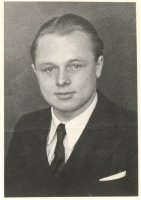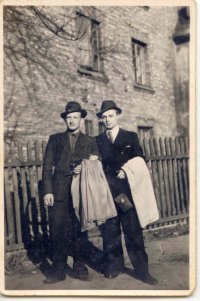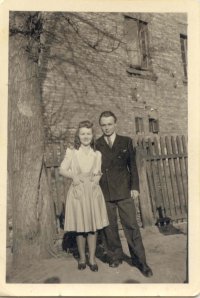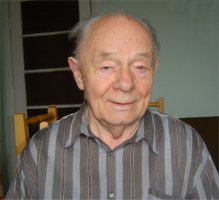
Eugeniusz Tyrajski,
born on the 8th of October 1926
Home Army soldier
pseud. "Genek," "Sek"(= a snag)
K-2 company, "Karpaty" battalion
"Baszta" AK regiment
The insurgent relations of witnesses
The war memories of Eugeniusz Tyrajski - a soldier from "Baszta" -(= a tower)
Occupation
 |
|
I was born on the 8th of October 1926. My father, Jozef, was a director of stereotypies department in the printing press house at Marszalkowska 35 Street. Mum, Janina, was managing a household. Apart from me she was bringing up a younger sister Elzbieta. Just like my parents all my life I had lived in Warsaw. But I was born somewhere else. In 1926 in Warsaw there was some epidemic prevailing. Mum being afraid of the future descendant's death went out to family to a little town Nowe Brwilno in Gostynin administration unit near Plock. I was born there. I didn't suppose that this fact would have a significant meaning in one time of my war, quite complicated experiences.
Before the war we had been living at Lazienkowska Street the corner of Rozbrat Street near the stadium of a sports club "Legion." I was attending a public school nr.29 at Zagorna 9 Street, from which I graduated in 1939. As I learnt later on that same school four years earlier had been finished by Janek Bytnar "Rudy," (= ginger-haired).
I had been interested in sport since childhood. One could say I was brought up the "Legion" stadium. When I didn't get back home for a long time mum went to the "Legion" football pitch and here she found me. At the public school nr.29 there was having its location a scouting team 90 of Warsaw Scouting Team (WDH) whose member I was. Just before the war I had gained the scouting cross. Having graduated from the public school I passed exams to Batory gymnasium at Mysliwiecka Street.
When in September 1939 the war broke up we stayed in Warsaw. I was thirteen then. Just when the war action had finished I started learning in Batory gymnasium. Unfortunately, after two months the school was closed down. Soon a secret learning at clandestine classes started. In 1940 I finished the first form of the gymnasium.
During the school year 1940/1941 I managed to go through the programme of two forms what later on resulted in the fact that I managed to take the Matura exam before the Uprising break-up. The clandestine lessons were conducted by a famous geographer, the author of geography books, after the war a director of the Geography Department at Warsaw University, Professor Gustav Wuttke. There were two sons that helped Professor in the clandestine lessons: Jas Wuttke and a younger one Tadzio Wuttke. Jas was a keen mathematician, an expert in the science: mathematics, physics, chemistry, while Tadeusz - a specialist in the arts: Polish, history. Father, apart from geography, taught social studies. In a tiny circle the learning went very well and effectively what allowed us to go through the programme of two forms during one year.
Both sons of Professor were active in the underground movement. Jan Wuttke was the later, famous "Czarny Jas" (= Black John) from "Zoska" company and then from "Zoska" Battalion where his younger brother Tadeusz "Maly Tadzio" served as well. In the springtime 1941 when the Wuttkes family knew me better and when Jas realized I'd been a scout before the war, he proposed to me that I could join the underground scouting movement. Both brothers were former pupils of Batory gymnasium and scouts of the 23 Warsaw Scouting Team (WDH), a popular "Orangery" from which soldiers of "Zoska" Battalion were recruited.
"Czarny Jas" proposed to me that I could organize a little patrol of several people among my friends. The patrol would be included in the structures of the Grey Ranks. Of course I accepted the proposition and I had become the Grey Ranks soldier since April 1941. I was then fourteen and a half. We were joined in the "N" action. It was about planting defeatist newspapers and leaflets on Germans in the German language.
One among others there were magazines "Der Klabautermann" and "Der Hammer" for German soldiers. Materials were edited by Polish secret journalists, knowing German perfectly well. The literature was planted on uncovered cars, put in the pockets of soldiers standing on the tramway platforms. Those kinds of activities were the easiest to be carried out by young, energetic boys that we were then numbered among such ones.
Our four-person group was supplemented with next three boys and with a patrol leader that was directed to us by "Czarny Jas." The patrol had a code name of "MG-410." MG was a code name of Upper Mokotow scout troop, 400 was the team number and 10 was the patrol number. The first patrol in the team 400. The scout troop "Upper Mokotow" of the Grey Ranks was wholly included in the organization of a small sabotage of Wawer code name. The organization itself of the underground scouting had existed in fact since the 27th of September 1939 though without using its formal name then of the Grey Ranks.
We took up broader and regular actions with a whole patrol (usually once a week) that apart from the newspaper distribution they were about painting on the walls the symbols of Poland Fighting (an anchor), occasional names ( 3rd May Anniversary, 11th of November), posting up anti-German posters. We had a special stamp with Hitler's caricature and with an inscription "Creepler" with which we validated the German posters. We took part in the actions of tearing off and destroying German signposts, pouring hydrochloric acid over uniforms of German soldiers (the most successful it was in the crowded trams) etc.
For the actions of the small sabotage our patrol was assigned to one region. It was the area limited with the following streets: Ujazdowskie Avenues, Square of the Three Crosses, Ksiazeca, Ludna, Solec, Czerniakowska, Mysliwiecka, Szwolezerow, Agricola, Square at the Corner. The actions were rather difficult to be carried out, as it was a German district. We acted mainly in the evening, in the dark, just before the curfew. In the patrol there were conducted shooter's fundamental military exercises as well: theory lessons and practical lessons in the field, acquaintance with the basic guns (small arms and kb - rifles).
The patrol was made of young boys, some of them were younger than me. Our activity in the small sabotage was treated like a good fun, that was performed with pleasure. We rather didn't realize the danger, as we displayed a lack of imagination characteristic for the young age. It was true we heard sometimes about unmasking during such a job but we didn't allow the thought that the same could happen to us. There were some moments we experienced some emotions but everything ended happily.
Some actions were carried out as "unscheduled" behind the superior's back. During the scouting oath ceremony of the Grey Ranks that took place in the flat at Rozbrat 4 Street, of one of the members of our patrol - Kazik, on the floor there was lying a red German flag with Hakenkreuz (= a crooked cross; a swastika) while in the whole flat around there were standing or hanging about 10 German signposts. There was also a mast made on purpose with little flags of Poland, Great Britain, France and the United States. Thanked to the contacts of "Czarny Jas" that was the team leader, we took an oath on the hands of Stanislaw Broniewsky "Orsza." Also the troop leaders of the Upper Mokotow Scout Troop Tadeusz Zawadzki "Zoska" and Jan Bytnar "Rudy" took part in it.
For All Saints' Day we decided to commemorate soldiers fighting for the independence of Poland and to lay a wreath in the main plot of soldiers from 1920. Girls sewed for us a sash with a majestic inscription "To the fallen brothers in arms - MG 410." We went there to the Soldierly Powazki Cemetery in the morning as there were less people. We bought a wreath, we attached the sash taken out from the pocket. Two boys were carrying the wreath, two boys were holding the sash. Getting to the place and laying the wreath our leader "Tadeusz" gave a command:" Stand to attention!" A moment of silence, and another command: "At ease, march off." For that action our leader took a sound beating and so did we. As that sash was a complete stupidity - an unmasking of the patrol.
The 10th of November 1942, the eve of the anniversary of gaining the Independence, in the evening hours at Mysliwiecka Street (in the region of our patrol activity) we were painting an anchor on the wall. Kazik is painting, I'm holding a cup with an asphalt paint and am observing whether nobody is coming. I can see that from the upper side of Gornoslaska Street a some old woman is going. It is November, shadows, poor visibility. Seeing no danger we keep on working .Suddenly we can hear a scream "Was machst du da?" As it turned out the approaching woman was German and started yelling. Kazik, thinking not too long, whisked her with a brush on the face. It was a very good paint, I suppose that the German woman couldn't wash it away for a week. We heard a car coming from the upper side of Gornoslaska Street out of which two Germans alarmed by the scream jumped. We did a bunk in a tiny Profesorska Street located nearby. Profesorska Street ran down the stairs to Wronski Street. We dashed like a hurricane. Germans started shooting in our direction, but it was dark, as black as ink, they didn't have any chance of hitting the target. And they weren't such heroes to chase us in the dark. We even saved the cup with paint. Usually we bought the paint in the shop called "Imroth and Malinski" at Marszalkowska Street. A popular company, befriended with underground activists. One entered the shop with a tiny cup wrapped in the newspaper. One of the workers, well-aware of the situation, came up, took the tiny cup and gave it back filled up after a while. We didn't pay for the paint. They knew what it was used for. The tiny cup was enough for many captions and anchors. The asphalt paint was the best. Still many years after the war one could see an anchor painted by us in the place described above.
Some other time, with Kazik as well we were validating with a stamp "Hycler" (= "Creepler") German posters about organizational directives, and announcements of mass executions. We noticed we were being observed by a young man in civilian clothes. With lightning speed we jumped away and got separated. I went along one side of Czerniakowska Street, Kazik along the other one. Near the house at Czerniakowska 225 Street suddenly somebody grabbed me by the hand. "Halt!" The scuffle started. I managed to break free. Divine Providence stood guard over me. Through the middle of the street in the direction of Czerniakow a tramway arrived. I jumped in a flash into it. Then the trams didn't have shut door. Young, fit people very often jumped into them on the run. Out of the corner of my eye I saw that Kazik was tussling with somebody as well. We got off at the first stop at Szara Street and through the passages known to me only among the houses and holes in the fences I got home at Fabryczna Street (I'd been living here since Germans expelled us from Lazienkowska Street). Just at home when the emotions fell did I realize how serious problems I'd avoided. Kazik, written off already by me, happily got home as well.
Kazik was doomed. When he took part in the actions of a little sabotage we usually had trouble. Kazik's father died in September 1939, mother in the winter 1940-41 of pneumonia. The boy was sixteen then. A younger brother and a sister were looked after by the family. Kazik was living by himself in a tiny room without comforts. His fittings consisted of a tiled stove only for which he needed fuel. We tried to help him tearing off German boards that were signposts informing about the location of different German institutions. They had an average size of 100x25cm and about 3cm thick. The boards were covered in paint. They were just a marvellous source of fuel. Having put down all the boards in the nearby vicinity we were spreading our activity on a wider and wider area.
One day, in the evening, we found ourselves on the Square at the crossroads by the tram-stop opposite Szucha Avenues. About 15 metres from the stop, on a post sunk in the ground about 2 metres high and 10x10cm thick there were fastened two boards. The temptation was strong. There were three of us: Kazik, Jurek and me. We were waiting for the arrival of the tram. When a commotion started on the stop we jumped to the post and tried to tear off the lower board fastened 1-1,20m high with metal grips. The whole post started moving. We jumped away - what to do next. An instant decision - we're taking the whole post.
We are waiting for the next train. A little commotion started, we jumped close to the post, we leant under the lower board and pulled out the whole up. The whole fell down to the ground, there was made a mess as hell. We are exciting the interest of people standing at the stop. But it is a German district, nobody knows how many of those people are Germans. After all they can be there in civilian clothes. We caught the heavy post with two fastened boards and set off on the double in the direction of Agricola. It was dark, as black as ink. Now in that place there is Lazienkowska Route. Then there was a square, near there was Rau's ice rink. We had always on us the appropriate equipment: a hammer, a pair of pliers, a pair of pincers. Instantly we unscrewed the boards, pushed them into the bag, left the post on the ground and set off in a hurry down to Agricola. Boards were protruding a little bit from the bag.
When we were at the level of Sobieski Statue we heard up a noise of a car that was sweeping both street sides with a searchlight installed on the roof. Then there was no free passage between Lazienki and Agricola. Along the street there was an endless fence, an alley in the middle, there was no place to hide. The car was approaching. We were lucky nevertheless. Germans didn't spot us. The car drove further on, and then turned back. All the time we were lying motionlessly. The car drove near us and got back to Ujazdowskie Avenues. We still waited for 15 minutes and triumphantly we got back to Kazik's home with a new portion of the fuel for him.
Some other time we were selling special supplements to "the New Warsaw Courier" newspaper that was an official publication for Poles. They were false copies with the appropriate headline on the front-page masking the right content. I remember e.g. the edition with a big title "Spain joined the war." Of course Spain didn't join any war, but the title pulled a little the wool over the eyes. One should circulate the newspapers as fast as possible. Actually they were intended for the free distribution, but we sold them, gaining this way funds for lonely Kazik.
Kazik didn't last out to the war-end. After the praiseworthy activity under the pseudonym "Farys" in the famed "Ninth Sabotage" DB-17 he was arrested by Gestapo and on the 12th of November 1943 shot in the street execution on Nowy Swiat at Warecka Street. Jurek taking part in the action with boards fighting in the ranks of the Ninth Sabotage Company "Zniwiarz"(= a reaper) died on the 3rd of August 1944 in the Warsaw Uprising on Zoliborz, torn apart by the artillery grenade together with a nurse treating him.


On a stroll with a friend A meeting with a friend
At the end of 1942 in the house where our leader lived there had been an unmasking and he had to leave Warsaw. Because of the fact our group was subject to a kind of reorganization. We were scattered so as to avoid the unmasking. Because of the skills of cooperating with the younger than me, I was directed by "Czarny Jas" to the Childcare Centre of the Reverend Siemiec at Dluga Street where children and teenagers of arrested, transported or murdered by Germans parents stayed. Out of the youngsters, after the right preparation, there were to be made new patrols of the scouts of the Grey Ranks. I took part in that action till February 1943 (I was sixteen then).The job was certainly responsible and useful in a further perspective of time. All the same, after a very dynamic activity in the patrol MG-410 such a calm and quite monotonous job didn't suit my nature. So when a friend-one year older than me- proposed to me that I should go to "Baszta" I agreed without hesitation.
Nota bene, I was lucky one more time. Two weeks later when I'd finished my activity in the Reverend Siemiec's Centre there was a serious unmasking. Lots of people were arrested, that ended up in Auschwitz. I had been directed earlier by the Fate somewhere else.
"Baszta" was born in Poniatowski's gymnasium at Zoliborz. First it was a battalion and then it was "Baszta" regiment. I landed in the team of the first platoon commanded by Corporal "Zawisza" in "Howerla"'s company still "Baszta" then. The commanding officer of the company was the co-originator of "Baszta" Ludwik Berger pseud. "Goliat," "Michal," "Hardy" that I personally met. He died on the 23rd of November 1943 in the skirmish with Germans at Smiala Street on Zoliborz. Now there can be found a commemorative plaque.
One should know that the name "Baszta" (= a tower) doesn't come from any "tower." The expanding "Howerla"'s company was transformed into a battalion that because of very good training results was taken over by the Main Headquarters of Home Army as a staff battalion BA-SZTA. [BA- two first letters of the Polish name for Battalion - "batalion= ba-"; SZTA- four first letters for the Polish name for staff- "sztabowy= szta-"]. It was the source for the name of the battalion and then of the regiment. Only then was the association with the name "baszta" (=a tower) used whose symbol can be found on the regiment stamp.
Just like other units our team was subject to a very intense training work including theory, practical lessons with small arms kb and the machine gun. Corporal "Zawisza" went out with us for lessons in the field especially to the forests on Otwock-line, and also to the Kampinos Forest and to Chojnowskie Forests. Lessons in the field, especially in 1943 were led by the whole team almost every Sunday, and usually included a two-day period (Saturday and Sunday). On the route there were still bunkers from the period of 1939 where we stayed overnight. Corporal "Zawisza" was horribly demanding, what as it turned out later during the Uprising was very useful.
At the end of 1943 as a result of a constant personal increase of the staff battalion "Baszta" was changed in "Baszta" regiment. The former company was divided into two companies. In "Baszta" regiment there were three battalions: "Baltyk," "Karpaty," and "Olza." Companies of the individual battalions got code names B-, K- and O-. Out of "Howerla"'s company the "B-1" company was made and assigned to the "Baltyk" battalion, while "K-2" was assigned to the "Karpaty" battalion . Me with my first platoon and patrol, we landed in K-2. In the wintertime 1942/44 I became a section representative in the patrol and was sent for the Course of Younger Commanding Officers. It was an equivalent of the Officer Cadet School where those without Matura exams were accepted. Simultaneously I was learning all the time at the clandestine lessons preparing myself for Matura exam.
At the beginning of May 1944 one member of our patrol was arrested, Tadeusz Dalkiewicz "Salwicz." In order to avoid the unmasking the commanding officer of the company ordered everybody who kept a private contact with the prisoner an instant trip for the partisan fight in the regions of Kielce and Lublin. For me it was a serious problem - in June I was to take Matura exam (school-leaving examination) during clandestine lessons. I reported to the commanding officer Piotr Slowikowski "Pawlowicz" and told him about my problems. The commanding officer said: "I understand. You're right. One should care about education." He let me stay in Warsaw on condition that I wouldn't go home anymore. So it happened. I didn't get back home. I stayed overnight at friends and family. Thanked to the positive decision of my commanding officer on the 1st of July 1944 I passed the last Matura exam.
"Salwicz" seemed to be a brave man. Germans didn't appear in any of his friends' house. After the war we learnt that both he and his arrested mother they died in the labour camp in Stuthoff.
After the arrest of "Salwicz" and going out of the majority of our friends (including the commanding officer of the patrol "Zawisza") for the partisan fighting the leadership was taken over by Corporal Officer Cadet Leszek Czaykowski "Jastrzebiec II." I was his second in command. "Jastrzebiec II" set about to completing the line-up, reorganizing the patrol and with a full success he conducted with my participation the basic military training of the patrol. In July boys from the partisan group from the Lublin regions got back, as there had been already coming the front. The time of the Uprising was coming.
Eugeniusz Tyrajski

|
Eugeniusz Tyrajski, born on the 8th of October 1926 Home Army soldier pseud. "Genek," "Sek"(= a snag) K-2 company, "Karpaty" battalion "Baszta" AK regiment |
elaboration: Maciej Janaszek-Seydlitz
translation: Małgorzata Szyszkowska
Copyright © 2011 Maciej Janaszek-Seydlitz. All rights reserved.